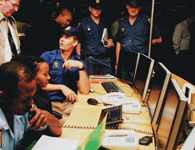
The City of Tshwane Metropolitan Municipality makes use of a surveillance technology system and interactive control room to reduce crime in the suburbs of Pretoria –with impressive success.
In 1998 Business Against Crime was instrumental in starting city centre surveillance initiatives and CCTV cameras were installed in Cape Town's central business district (CBD). From BAC was born Cueincident, a private surveillance technology company that then provided similar solutions for both Johannesburg, in 1999, and Pretoria in December 2004.

"The system used in Pretoria is true state-of-the-art," says Japie Lerm of the City of Tshwane Metropolitan Police. "What differentiates it from other city surveillance projects is that it is interactive and has the ability to track and trace suspects."
The multimillion rand project, which currently makes use of 68 cameras, was awarded by the City of Tshwane Metropolitan Municipality for a period of five years and is implemented through a joint venture company called Cueincident-Morubisi Operations, which is managed by Morubisi.
CCTV surveillance cameras have been installed in the Inner City Business District, Sunnyside, Hatfield, Marabastad, the taxi rank between Boom and Bloed Streets and the area around Loftus Versveld Stadium, the latter specifically in preparation for the 2010 FIFA Soccer World Cup.
Sixty-eight cameras may not seem like a lot considering the area that they cover, but as Pitiki Moraka, a founder member of Morubisi, explains, it is all in the positioning of highly effective cameras to provide optimum surveillance ability, coupled with the interactive control room.
The control room hosts three 'lines' of operators. The first line consists of six operators, each monitoring sets of 12 screens. The operators have the ability to pan, tilt and zoom the Pelco cameras remotely for optimal viewing of the areas being covered. If a potential criminal activity is observed, the front-line operator notifies the next line of operators who watch the footage on a star formation of monitors and have the ability to track and trace the suspicious-looking characters being filmed.
If, at this stage, it is clear that there is a crime in progress, the third line of operators is alerted. These are members of the Metropolitan Police and the South African Police Services, who are then able to communicate with policemen in the relevant areas to ensure speedy arrests.
The operators are specially trained in body language and selected on vigilance. They have 45-minute shifts in front of the monitors and are rotated randomly to view different monitors. Operators are screened and also monitored by CCTV cameras in the control room.
"The system works as a facilities management solution, not just for security," Lerm points out. "It can be used to manage traffic lights, accidents, water problems, street lights etc. Ideally, I would like to have a representative with the relevant training from each of the emergency services sitting in the control room with a radio. They could then communicate problems directly to their peers and this would allow a faster response to any kind of emergency picked up on the cameras.
"From a security point of view, the solution is working - there has been a 65% reduction in crime in the areas where the cameras have been installed and we are in negotiations with other City Improvement Districts in the city to roll the project out into their areas as well. Funding is always a problem, though, and we do rely on businesses in the areas to assist the municipality with the project by sponsoring some of the cameras."
Offences captured on camera include public drunkenness, drug possession, muggings, theft from motor vehicles and traffic offences.
The council uses the surveillance cameras to identify traffic violations such as double parking, drivers who unload their goods while parked in the middle of the road and dangerous parking, and issue 'spot' fines to offenders.
"The South African National Road Agency has implemented the same cameras for their project on some highways and there is the possibility of integrating with that camera system. If all municipalities installed systems that could integrate with each other it would go a long way in clamping down on crime across the country," Lerm concludes.
For more information contact Cueincident, +27 (0) 11 331 2100, [email protected], www.cueincident.com
© Technews Publishing (Pty) Ltd. | All Rights Reserved.